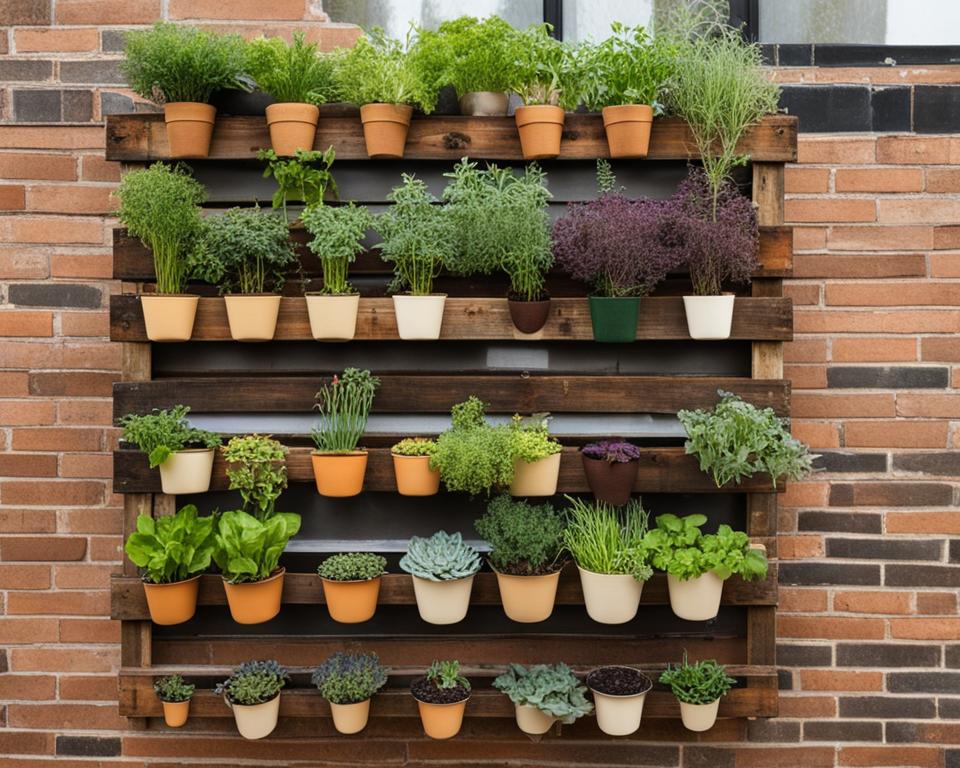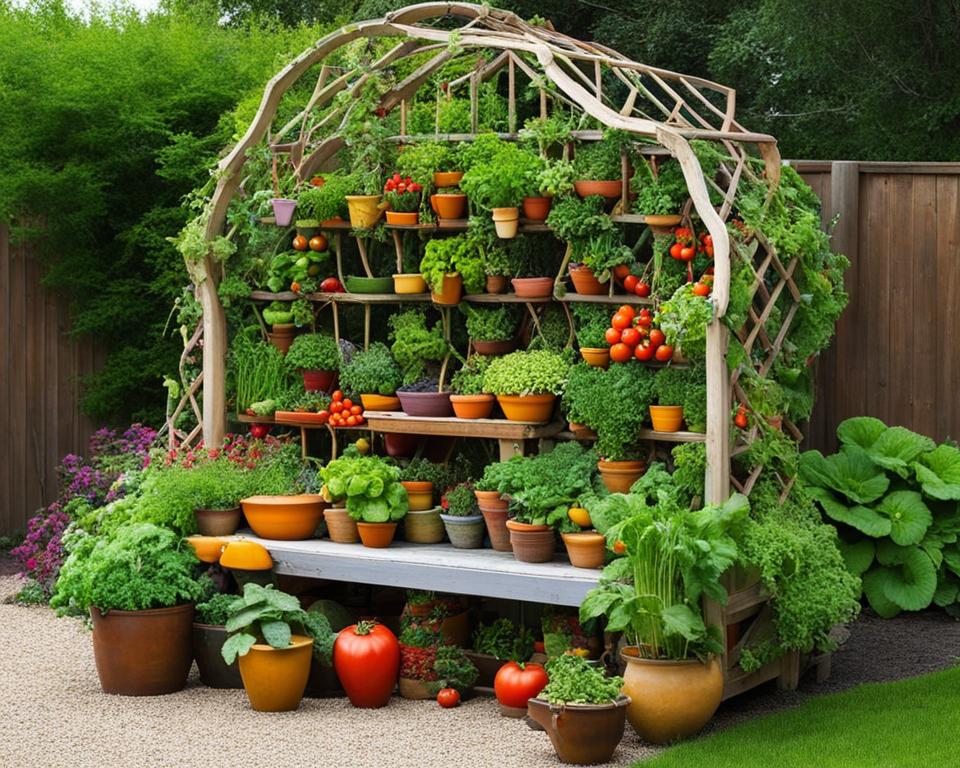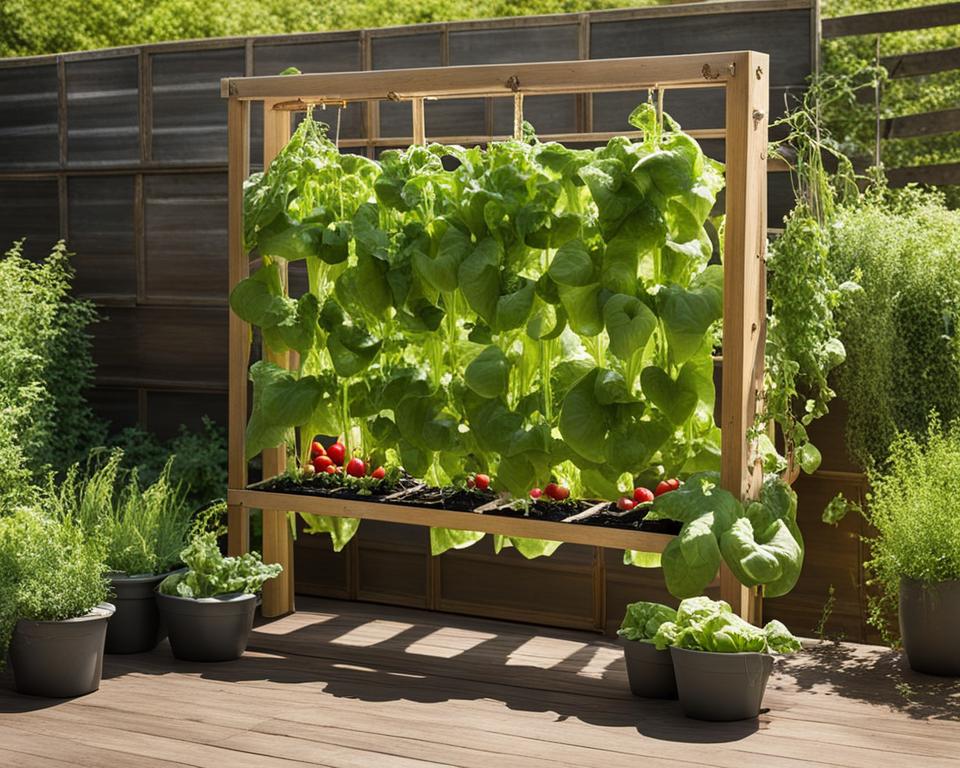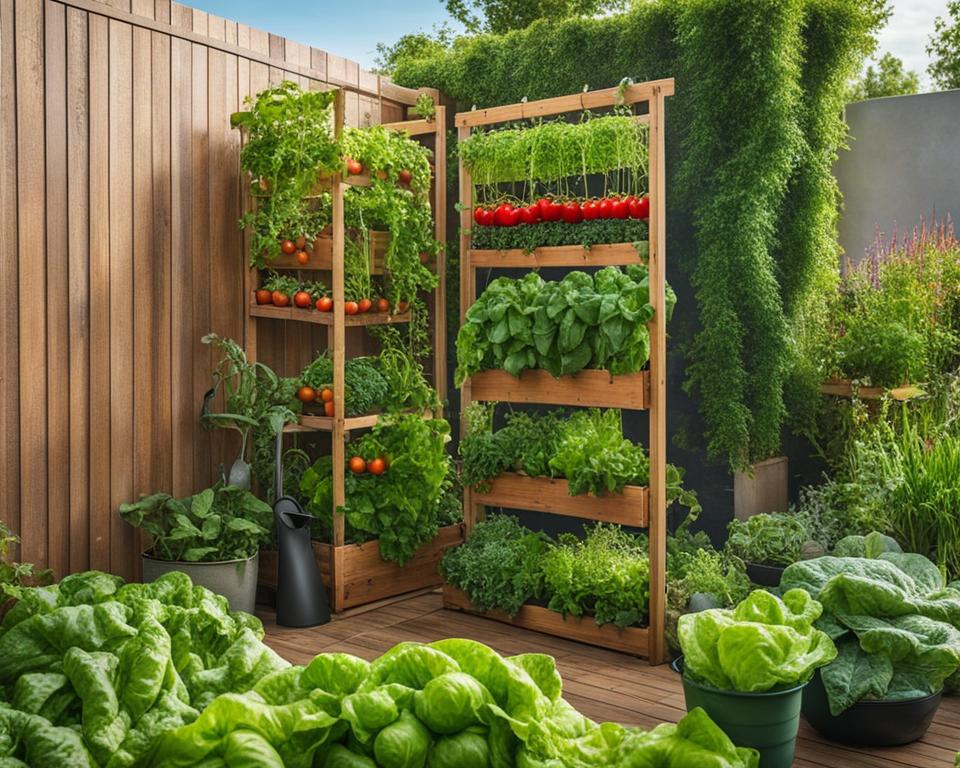Are you a vegetable gardening enthusiast who is short on space? Do you want to grow your own fresh produce but don’t have a backyard? No problem! Vertical vegetable gardening is the perfect solution for small-space gardeners. And, where better to find inspiration for your vertical garden than on Pinterest?
Pinterest is a social media platform that allows users to discover and share various ideas and interests through images, videos, and links. It is a great resource for gardeners looking for innovative solutions to maximize their limited space and grow delicious vegetables.
On Pinterest, you’ll find a plethora of vertical vegetable gardening ideas that will inspire you to take your gardening game to the next level. From DIY vertical structures to unique plant arrangements, the possibilities for vertical gardening are endless on this platform.
Key Takeaways:
- Pinterest is a great resource for finding vertical vegetable gardening ideas
- Vertical gardening is the perfect solution for small-space gardeners
- Explore innovative solutions to maximize your limited space on Pinterest
- DIY vertical structures are a popular trend in vertical vegetable gardening
- Get inspired to take your gardening game to the next level with unique plant arrangements
Find Space-Saving Vertical Gardening Designs
If you’re looking for ways to maximize your small space and still have an amazing vegetable garden, then vertical gardening is the perfect solution. By growing your veggies upwards, you can create a beautiful and productive garden even if you only have a small balcony or patio.
One of the best things about vertical gardening is that there are so many space-saving designs to choose from. Here are some of the most popular:
Vertical Vegetable Walls
Vertical vegetable walls are an innovative way to grow a lot of plants in a small area. You can create your own wall using a variety of materials like wood, metal, or plastic. These walls can be mounted on any surface, including fences, walls, and even indoors. You can grow a variety of vegetables on your wall, including tomatoes, cucumbers, and herbs.
Hanging Planters
Hanging planters are another space-saving solution for vertical gardening. You can hang them from balconies, patios, or any vertical surface. These planters come in a variety of sizes and shapes, from small pots to large baskets. You can grow a variety of vegetables in hanging planters, including lettuce, strawberries, and tomatoes.
Trellises
Trellises are a traditional way of growing climbing plants like tomatoes, beans, and cucumbers. By creating a trellis, you can support your plants as they grow vertically. You can make your own trellis using wood, bamboo, or metal.
Pyramid Gardens
A pyramid garden is a unique way to grow a lot of plants in a small area. These gardens are made up of multiple tiers, each with its own set of plants. You can even create a pyramid garden using only vertical space, by stacking tiers on top of each other.
https://www.youtube.com/watch?v=e_POG-Nc5FAI love vertical gardening because it allows me to grow so many vegetables in a small space. I have a small balcony, but I still manage to grow tomatoes, herbs, and peppers using hanging planters and trellises.
Whether you prefer a modern or traditional look, there’s a vertical gardening design that will suit your style. Get creative and experiment with different designs to find the perfect one for your space.
DIY Vertical Gardening Tips
Are you ready to take on the challenge of building your own vertical garden? With these DIY vertical gardening tips, you’ll be able to create a stunning and functional vegetable garden that will delight you every day.
Choose the Right Structure
First and foremost, you need to decide on the right structure for your vertical garden. Depending on your available space, you can choose from a variety of options, such as a vertical garden wall, a trellis, or a hanging planter. Look for user-friendly tutorials on Pinterest or online forums to find the perfect design for you. Make sure to take into account the weight of your plants and the quality of the materials you choose to ensure a sturdy and long-lasting structure.
Use the Right Soil and Plants
Another crucial aspect of vertical gardening is using the right soil and plants. Unlike traditional gardening, where plants can spread their roots and grow as big as they want, vertical gardening requires lightweight soil that won’t weigh down your structure. Choose a high-quality potting mix that contains all the necessary nutrients and minerals for your plants.
When it comes to selecting plants for your vertical garden, opt for those that have shallow root systems and don’t require a lot of space. Some great options include lettuce, kale, spinach, and herbs. You can also experiment with hanging planters to grow cherry tomatoes, peppers, and strawberries.
Watering and Maintenance
Proper watering is essential to keep your vertical garden healthy and vibrant. Make sure to water your plants frequently, especially during hot summer months. To avoid water damage to your walls or floors, use a drip irrigation system or a watering can specifically designed for vertical gardening.
Regular maintenance is also key to keeping your vertical garden thriving. Remove any dead or wilted leaves, prune your plants when necessary, and keep an eye out for any signs of pests or diseases. In case of an infestation, consult with a gardening expert to find the best treatment options.
With these DIY vertical gardening tips, you’ll be able to create an impressive and productive vegetable garden that will make the most of your limited space. So, roll up your sleeves, get your hands dirty, and enjoy the beauty of vertical gardening!

Maximizing Small Spaces with Vertical Vegetable Gardening
When it comes to small space vegetable gardening, it’s all about making the most of your limited area. That’s where vertical vegetable gardening comes in. By utilizing your vertical space, you can grow a range of vegetables even in the smallest of areas.
One of the first things to consider when planning your vertical vegetable garden is the amount of sunlight your space receives. Vegetables typically need at least six hours of direct sunlight each day, so be sure to choose a location that gets enough sun. You can also use a trellis or other vertical structure to position your plants so that they receive adequate sunlight.
Another essential aspect of vertical vegetable gardening is proper soil and drainage. Be sure to choose a well-draining soil that’s appropriate for the types of vegetables you want to grow. Additionally, consider using containers or raised beds to ensure proper drainage and avoid waterlogging your plants.
One advantage of vertical vegetable gardening is the ability to grow a variety of vegetables in a small space. For example, you can grow tomatoes, cucumbers, and beans vertically, allowing you to have a range of fresh produce right at your fingertips.
To further maximize your small space, consider using a companion planting strategy. Companion planting involves growing complementary plants close together to maximize productivity and minimize pest issues. For example, planting marigolds near your tomatoes can help repel pests and boost overall plant health.
Overall, vertical vegetable gardening is an excellent option for those with limited space. With the right techniques, you can grow a bountiful vegetable garden even in the tiniest areas.
Comparing Container Sizes for Small Space Vegetable Gardening
| Container Type | Size | Pros | Cons |
|---|---|---|---|
| Window Box | 24″ x 6″ x 6″ | Can be hung on balcony railing or windowsill, perfect for herbs and small vegetables | Small size limits types of plants that can be grown, can be difficult to water |
| 5-Gallon Bucket | 12″ diameter x 14″ high | Inexpensive, easy to move around, great for larger plants like tomatoes and peppers | May need to drill drainage holes, can be bulky |
| Vertical Garden Planter | 36″ x 20″ x 18″ | Maximizes vertical space, can grow a variety of vegetables and herbs, self-watering options available | Expensive, heavy, may require assembly |

One of the most popular trends on Pinterest for vegetable gardening is using repurposed containers. From old buckets and cans to teapots and colanders, the possibilities are endless. Not only is this a creative way to upcycle items around your home, but it’s also an effective way to grow a variety of vegetables in small spaces.
| Materials | Veggies to Grow |
|---|---|
| Old Buckets | Tomatoes, Carrots |
| Colanders | Lettuce, Herbs |
| Teapots | Peppers, Radishes |
Vertical Herb Garden
If you’re looking for a space-saving solution for growing herbs, a vertical herb garden is a great option. Not only will it save you valuable floor space, but it also adds a visually appealing element to your outdoor space. Pinterest is full of creative designs for vertical herb gardens, such as using a wooden pallet or hanging planters.
“I never thought of using a pallet as a herb garden. Such a great idea!” – Pinterest User
Unique Plant Arrangements
For those looking to add a unique touch to their vegetable garden, Pinterest has plenty of creative plant arrangement ideas. From arranging vegetables in geometric patterns to mixing different varieties of vegetables in one container, the possibilities are endless. Not only is this a visually appealing option, but it can also help with pest control by confusing pests with the mixed aromas of different vegetables.
- Geometric Patterns: Carrots, Beets, Tomatoes
- Mixed Variety: Cucumbers, Lettuce, Peppers, Radishes
With so many creative vegetable gardening ideas available on Pinterest, you’re sure to find inspiration for your next gardening project. Whether you’re working with limited space or just looking for a unique touch, the possibilities are endless.
Practical Tips for Successful Vertical Vegetable Gardening
Vertical vegetable gardening can be an excellent solution for those with limited space and a desire to grow their produce. However, it can be challenging to get it right the first time. Here are some practical tips that will help ensure success in your vertical vegetable garden:
Choose the right plants
When selecting plants for your vertical garden, consider the amount of sunlight and shade the area receives. Some vegetables require full sun, while others can tolerate partial shade. Additionally, choose plants that have compact growth and do not require extensive root systems.
Use the right soil
The soil used in your vertical garden should be well-draining and nutrient-rich. Consider using a lightweight potting mix with added perlite or vermiculite for proper drainage. Fertilize regularly to provide your plants with essential nutrients.
Water frequently
Vertical gardens tend to dry out faster than traditional gardens. Therefore, it is crucial to ensure your plants receive adequate water. Consider using a drip irrigation system or a watering wand to ensure that each plant receives the right amount of water. Be careful not to overwater, as this can lead to root rot and other problems.
Use trellises and supports
Many plants in a vertical garden require support to grow upward. Consider using trellises or stakes to keep your plants growing tall and strong. This also helps to keep the plants off the ground, reducing the risk of pests and diseases.
Consider companion planting
Companion planting is a technique that involves planting different types of plants together to improve growth and repel pests. For example, planting marigolds with your vegetables can help to deter pests like aphids and whiteflies.
Control pests and diseases
Vertical gardens tend to be at higher risk for pests and diseases due to their compact nature. Monitor your plants regularly for signs of damage or disease, and take action immediately if you notice any problems. Consider using natural pest control methods, like neem oil or ladybugs, to keep pests at bay.

“By implementing these practical tips, you can ensure a successful vertical vegetable garden that yields a bountiful harvest and brings joy to your home.”
Achieving a Lush, Green Oasis through Vertical Vegetable Gardening
Vertical vegetable gardening not only helps maximize your limited space but also transforms it into a beautiful, lush green oasis. By incorporating vertical garden structures and creative plant arrangements, you can create a visually appealing garden that enhances your outdoor space.
In addition to its aesthetic appeal, vertical vegetable gardening has numerous benefits. It increases oxygen production, improves air quality, and can even help reduce energy costs by providing shade and insulation.
To create a visually stunning vertical garden, consider incorporating a variety of plants with different colors, textures, and heights. For example, combine trailing plants with tall, leafy plants to create a diverse and vibrant display.
You can also experiment with different types of planters and containers, such as repurposed pallets or hanging baskets, to add a unique touch to your garden.
Pinterest is a great resource for finding inspiration for your vertical vegetable garden. Check out different gardening ideas on Pinterest and experiment with different designs to find what works best for your space.
Vertical Gardening Inspiration on Pinterest
Looking for some vertical gardening inspiration? Look no further than Pinterest! With endless ideas and stunning photos, Pinterest is the ultimate destination for anyone looking to get creative with their gardening. Here are some of my favorite vertical gardening ideas that I found on Pinterest:
Repurposed Containers
Why use traditional planters when you can repurpose everyday items for your vertical garden? Pinterest users have come up with all sorts of creative container options, from old tires and boots to gutters and birdcages. Not only is this an eco-friendly option, but it also adds an extra touch of character to your garden.
Vertical Herb Gardens
If you love cooking with fresh herbs, consider creating a vertical herb garden on your patio or balcony. Pinterest users have come up with all sorts of creative ways to do this, from using a hanging shoe organizer to repurposing a ladder. Not only does this add a beautiful touch of greenery to your space, but it also provides easy access to fresh herbs for all your culinary creations.
Living Walls
Living walls are a stunning way to bring some life to your outdoor space. Whether you opt for a simple succulent garden or a full-blown living wall installation, this is sure to be a showstopper in your garden. And the best part? Living walls are great for those with limited square footage, as they don’t take up any floor space.
DIY Trellises
Creating your own trellis is a great way to add some vertical interest to your garden, while also providing support for climbing plants like tomatoes and cucumbers. Pinterest is brimming with DIY trellis ideas, from simple wooden structures to repurposed ladders and even bike wheels.
So go ahead and dive into the world of vertical gardening on Pinterest. Who knows what creative ideas you’ll come up with for your own garden!
Innovative Vertical Vegetable Gardening Ideas
Are you looking to take your vertical vegetable gardening to the next level? Look no further than these innovative ideas that are sure to inspire and impress.
Hydroponic Vertical Gardens
Hydroponic gardening is a soil-free method of growing plants using nutrient-rich water. Vertical hydroponic gardens are becoming increasingly popular, as they allow for maximum space utilization and high crop yields. These gardens use a variety of methods, including nutrient film technique, deep water culture, and drip systems, to provide optimal growing conditions for plants.
Aeroponic Vertical Gardens
Aeroponic gardening is a soil-less method that uses mist to provide plants with nutrients and oxygen. By suspending plants in air, it allows for maximum oxygenation and water conservation. Vertical aeroponic gardens can be created using towers or hanging structures, and can produce high yields of nutrient-dense vegetables.
Smart Vertical Gardens
Smart technology is revolutionizing the way we garden, and vertical gardens are no exception. From automated irrigation systems to sensor-based nutrient delivery, smart vertical gardens use technology to optimize growing conditions and provide real-time data on plant health. These gardens provide an excellent solution for busy gardeners who want to grow their own vegetables without spending hours tending to their plants.
| Traditional Vertical Gardens | Innovative Vertical Gardens |
|---|---|
| Simple trellises or stakes used for climbing plants | Hydroponic, aeroponic, or smart vertical gardens |
| Limited plant variety due to space constraints | Maximized space utilization with high crop yields |
| Requires frequent watering and maintenance | Automated systems for optimal growing conditions |
These innovative vertical vegetable gardening ideas offer exciting possibilities for anyone looking to grow their own vegetables in limited space. Whether it’s a hydroponic tower or a smart vertical garden, these solutions provide a unique and efficient way to grow fresh produce from the comfort of your own home.
Embrace the Beauty of Vertical Vegetable Gardening
Vertical vegetable gardening not only maximizes your limited space but also adds an aesthetic appeal to your home. A well-designed vertical garden can enhance your outdoor space, add a touch of greenery, and become a beautiful focal point in your home.
Imagine waking up to the sight of lush greens and vibrant colors every morning, sipping your coffee while enjoying the beauty and fresh air around you. With vertical gardening, this dream can become a reality.
One of the best places to find gardening ideas on Pinterest, where you can explore the endless possibilities and get inspired. Whether you want to create a dramatic vertical garden structure or a simple hanging planter, Pinterest’s collection of vertical vegetable gardening ideas has got you covered.
Don’t be afraid to mix and match colors, textures, and shapes when choosing plants for your vertical garden. Consider using different varieties of lettuce, herbs, tomatoes, and cucumbers to create an eye-catching display of edible greens.
And, if you want to take your vertical garden to the next level, consider incorporating unique planters, like repurposed containers, or adding lights to create a magical ambiance in the evening.
With endless possibilities, vertical vegetable gardening can truly become a work of art. So, get creative, experiment with different designs, and embrace the beauty of vertical gardening.
Conclusion
As a professional copywriting journalist, I have explored the world of vertical vegetable gardening ideas on Pinterest and was amazed by the innovative designs and creative solutions available. From space-saving designs to DIY tips and tricks, there are endless possibilities for growing your own bountiful vegetable garden even in the smallest of spaces.
By embracing the beauty of vertical vegetable gardening, you can transform your limited space into a lush, green oasis that enhances your outdoor area and adds a touch of greenery to your home. Whether you’re a seasoned gardener or a beginner, Pinterest provides a wealth of inspiration and ideas to experiment with.
Experiment and Create
So go ahead, experiment with different designs, materials, and plants to create your own unique vertical vegetable garden. With proper plant selection, watering methods, sunlight requirements, and pest control strategies, you can ensure your vertical garden thrives, and enjoy the benefits of increased oxygen production and improved air quality.
With the help of Pinterest and these innovative and creative ideas, you can harness the full potential of vertical vegetable gardening and turn your limited space into a green haven. Happy gardening!
FAQ
Where can I find vertical vegetable gardening ideas?
You can find a plethora of vertical vegetable gardening ideas on Pinterest. It’s a great platform to discover innovative designs and creative solutions to maximize your limited space and grow a bountiful vegetable garden.
What are some space-saving vertical gardening designs?
Some space-saving vertical gardening designs include vertical vegetable walls, hanging planters, and trellises. These clever ideas make the most of your vertical space and are perfect for small areas.
Any tips for DIY vertical gardening?
Absolutely! We’ll share practical tips and tricks for DIY vertical gardening. You’ll learn how to build your own vertical garden structures and get expert advice on choosing the right materials, soil, and plants for successful vertical vegetable gardening.
Can I maximize small spaces with vertical vegetable gardening?
Definitely! Vertical vegetable gardening is a great solution for gardening in small spaces. We’ll discuss strategies for maximizing your available space and growing a variety of vegetables, even in the tiniest areas.
Are there any creative vegetable gardening ideas on Pinterest?
Absolutely! Pinterest is a hub for creative vegetable gardening ideas. From repurposed containers to vertical herb gardens and unique plant arrangements, these ideas will inspire you to create a stunning vegetable garden.
What are some practical tips for successful vertical vegetable gardening?
We’ll provide you with practical tips and techniques for successful vertical vegetable gardening. Learn about proper plant selection, watering methods, sunlight requirements, and pest control strategies to ensure your vertical garden thrives.
How can vertical vegetable gardening transform my limited space?
Vertical vegetable gardening can transform your limited space into a lush and green oasis. Explore the benefits of vertical gardening, such as increased oxygen production and improved air quality, and discover tips for creating a visually appealing garden.
Any vertical gardening inspiration on Pinterest?
Pinterest is full of stunning vertical gardening inspiration. From awe-inspiring vertical garden structures to beautifully arranged vegetable displays, these images will ignite your creativity and motivate you to start your own vertical vegetable garden.
Are there any innovative vertical vegetable gardening ideas?
Absolutely! We’ll explore innovative vertical vegetable gardening ideas that go beyond traditional practices. From using hydroponics and aeroponics to incorporating smart technology, these ideas push the boundaries of what you thought was possible in vertical gardening.
How can vertical vegetable gardening enhance the beauty of my space?
A well-designed vertical vegetable garden can enhance your outdoor space, add a touch of greenery, and become a beautiful focal point in your home. Discover the aesthetic appeal of vertical vegetable gardening and create a visually stunning garden.

